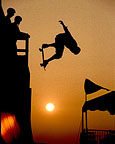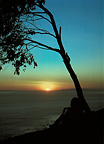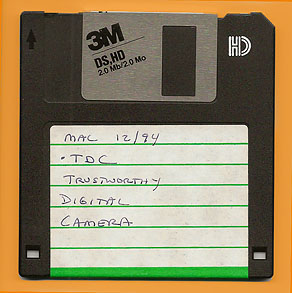











The Friedman Archives Newsletter
May 2009
In this issue:
How I Took This Shot
| I had the honor of photographing
the work of Sandra Shaw, a talented bronze sculptist who was
preparing for a museum opening and needed “head shots”
of several of her pieces. One of the pictures can be seen to the
right, and the somewhat-chaotic-looking garage in which it was shot
can be seen below.
|
 |
This professional-looking shot was made with only two wireless flashes, an umbrella (to soften the first flash), and a large white sheet (to provide the fill light). In the garage picture you can see a table and a tan-colored backdrop, an umbrella reflector holding Wireless Flash #1, and an assistant to the left of the bust, holding up a white sheet to act as a fill light to lighten the shadows.
Wireless Flash #2 (which you can see just below the table with a small card to limit how far the light spreads) was standing on the floor pointing up, so that the light was more intense near the bottom of the backdrop and gradually got darker the higher you go. Both Minolta 5600 flashes were placed on Manual output (just because I wanted to leave few things to chance). The final image was shot with an 80-200 f/2.8 lens set to f/9 at 1/160th of a second.
It's amazing the results you can get with the proper use of the humble wireless flash!! You can see more of Sandra Shaw's amazing work at www.SandraShaw.com .
Fast Image Selection: Take off your Glasses
Here is a technique I learned many years ago to help me quickly select my “keeper” pictures from hundreds of images shot in the field, thinking "I'll choose the good one later". Well, the more pictures you shoot the more time it takes to weed out the good ones, and after awhile you find you're spending way too much time in front of your computer.
This technique is drawn from my days of shooting slides the same way (hundreds at a time and I had to pick just one or two). The technique? Put as many slides on my light table as I could, take off my glasses, and just look casually at a distance for the slides that just leap out at you. Those will be the slides where the light is good, your composition is strong, and you have no distracting backgrounds. And it's really amazing -- usually in about 2 seconds you can find your winners, without having to spend time scrutinizing each shot. This is how photo editors choose images, too, so you might as well start thinking like they think. It's a good habit to develop.
Can this slide technique translate to digital photography? Sure! Just use a program that shows you small thumbnails as in the example below. Without having to look very hard, your good compositions should instantly be self-evident. This is your first-pass; after that you have far, far fewer images to scrutinize for sharpness or good expressions.

Does anyone here remember 1995? That was the year that Microsoft came out with a product called “Bob” which was meant to be a friendly user interface for newbies – you know, so your grandmother could finally use a personal computer. Interestingly, I never saw a grandmother (or anyone else in the program’s target demographic for that matter) write a product review for Bob. But I did see a plethora of reviews written by computer-literate users, all of whom trashed the product endlessly. As a result, all the bad press made Microsoft withdraw the product from the market before it really got a chance to help its intended audience.
In hindsight, it’s easy to see that the big problem here was that the people who were reviewing the product were not the ones for whom the product was intended, and that the established reviewers had a tendency to be kind of arrogant. (It’s like having the folks at IBM evaluate the utility of Twitter :-). ) Sometimes it’s not beneficial to have the experts evaluate the entry-level products.
I was reminded of Microsoft’s experience with Bob when I started reading the online reaction to Sony’s new entry-level DSLR lineup (which you can read about here). The new A230, A330 and A380 cameras are essentially re-issues of their popular A200, A300, and A350 cameras with the biggest difference being the new, friendlier user interface. “Boring!” and “I wouldn’t upgrade to THIS!!” were common reactions from the online discussion forums – users who are not in Sony’s target demographic for these cameras. I haven’t seen much of the new user interfaces myself (only what’s shown on the press release), but as a photographer and an educator about photography, I can’t help but feel pleased that somebody has finally leveraged the camera’s existing large display and ample memory and attempted to use them to soften the learning curve (a curve which can be quite intimidating to a beginner). And it didn’t cost them anything to do it, making one wonder why this kind of thing hadn’t been tried earlier. I look forward to writing about these cameras, and I will be sure to put them in the hands of somebody's grandmother so I can see just how effective (or not) the new UI is.
But wait! What's this? According to a thread on Dyxum.com, a possible new, unannounced 500 series of Alpha DSLRs has mistakenly appeared on the Sony Canada website! This would fill the missing gap between the just-announced entry-level DSLRs and the still-awesome A700 camera. Sony's been busy!!
Of course for me, the big news was the introduction of the new, tiny flash called the HVL-F20AM, which can act as a wireless flash controller when mounted atop an A900. (This addresses my biggest gripe about the A900, as described in a previous newsletter.) Obviously the new flash will be using the old wireless flash protocol (so it will be compatible with the older 36 and 56 flashes as well as the newer 42 and 58 flashes), but very little else is known technically about it. Be certain that when it becomes available for purchase in July I’ll be buying one, and will let you know what I think (and I’ll update the A900 book to include its details as well).
The Next Seminars: Nova Scotia, Nashville, and Manhattan
The old days were easy. Cameras like my trusty 1960's era
Minolta SRT-101 (which still works!)  had only two major
controls: f/stop, and shutter speed. Want autofocus?
You're it. Want to change the ISO or shoot in B&W
mode? Change film! The controls were straightforward,
and you didn’t need a 300-500 page book to understand how to
use it.
had only two major
controls: f/stop, and shutter speed. Want autofocus?
You're it. Want to change the ISO or shoot in B&W
mode? Change film! The controls were straightforward,
and you didn’t need a 300-500 page book to understand how to
use it.
So what has the modern day automation brought us? There's no question that automation in the form of AUTO mode has made taking pictures easy and simple (and get a higher percentage of usable shots than the old instamatics), but once you get out of AUTO mode things get insanely complex. Modern DSLRs have a gazillion automatic modes which, ironically, lengthens the learning curve since in order to understand what the whiz-bang features do, you have to first understand the basics of olden-day cameras.
But golly, it all seems so intimidating -- where do you start?
The answer is The Friedman Archives High-Impact Photography Seminars! This weekend seminar will condense all the essentials you need to know into two fun-filled days, giving you an intuitive understanding of the basics as well as finally understand what all those whiz-bang features actually do. More important than that, the secrets of taking pictures that make people say, "Wow!" are revealed, in a way that is fun, intuitive, and designed to stay in your long-term memory even after many years. Any photographer owning any camera brand is welcome (they're all good!), and as many before you have attested, the weekend is fun and worthwhile.
We have 3 (possibly four) lined up for the rest of 2009 (and many more for 2010):
| Nova Scotia, Canada | August 8-9, 2009 | Click here to sign up! |
| Nashville, TN | September 12-13, 2009 | Click here to sign up! |
| New York, NY | October 17-18, 2009 | Click here to sign up! |
| Encino, California | (Possibly in November) | Click here to express interest! |
(Many people have written to me and ask why Nova Scotia and not Toronto? The answer is a local photo club has invited me up there, and so they get first priority. Toronto and perhaps Halifax on an adjacent weekend are on the short list for 2010.)
Want the seminars to come to your city? Don't just wish for it -- register your interest!
A Sincere Endorsement
Many of you know that I enthusiastically endorse lots of products that I am thrilled about, without compensation. (Sometimes a negative endorsement happens, too!) Most of the time these endorsements involve photography, but when it comes to things that are really important, there's no sense in limiting oneself.
I used to catch colds on a regular basis. I always thought that this was a natural thing since I'm always staying up at all hours, traveling extensively and being out in foul weather. (And magadoses of Vitamin C, even though it can have negative side effects, didn't always help.) But about three years ago a family member turned me onto a vitamin supplement called Juice Plus. Since taking Juice Plus, I think I've only been sick once; and this is after spending days walking through London in the rain, enduring cold Russian nights, and hosting a photo expedition through Latvia. Both my wife and I are enjoying unprecedented wellness, and are so enthusiastic about the product that we are spreading the word like a couple of Jehova's Witnesses.
I've known for years that the nutrients in the popular vitamin supplements don't always get absorbed by the body - they get excreted instead. The basic premise behind Juice Plus is that they combine a full, complementary blend of fruits and vegetables (not isolated, synthetic chemicals) - enough to provide the body everything it needs to break down and absorb the natural ingredients. At first I was skeptical about the product claims and the way it is being marketed, but I am here to tell you that this is a product that works.
Again, I get no compensation for this - I am just a very, very satisfied customer. You can learn more about Juice Plus here. I also encourage you to contact the person who turned me onto this, Dory Clark (who is a pediatric nurse practitioner and works at the neonatal intensive care unit at a local hospital - she's a serious health professional!) if you'd like to ask questions or give this worthwhile product a try. Dory can be reached at dhclark718@gmail.com.
 In the computer world, many people
worry about "bit rot" (data erosion) when it comes to archiving old
data. And that's a good thing. But there's an even more
serious threat to data life than bit rot... it is format
change. Somewhere upstairs I have a low-density floppy disk
of a paper I wrote on an Atari 1040ST using WordPerfect. The
data is intact... but I defy anyone to read it!!
In the computer world, many people
worry about "bit rot" (data erosion) when it comes to archiving old
data. And that's a good thing. But there's an even more
serious threat to data life than bit rot... it is format
change. Somewhere upstairs I have a low-density floppy disk
of a paper I wrote on an Atari 1040ST using WordPerfect. The
data is intact... but I defy anyone to read it!!
In a similar vein, I also have a high-density floppy containing a paper I wrote 15 years ago outlining the technical details of the "Trustworthy Digital Camera" - an invention I eventually patented - which I need to be able to read but can't because I don't have easy access to a Mac. It was written on a Mac using OS 8 (Motorola CPU) and Microsoft Word, and I need to convert it into a .pdf file. It might be readily readable on modern equipment - I don't know. Can anyone out there help me in this quest? If so, please send an email to Gary@FriedmanArchives.com and I'll get this floppy into your hands!
For those who are wondering, the Trustworthy Digital Camera works just like any other digital camera. The difference being that if you took a picture with this camera, you'd be able to prove in court that the image had not been manipulated by computer. I thought this invention (like other inventions I came up with through the years) would change the world, and restore the rapidly eroding credibility that the printed photograph once enjoyed. (And to a small degree it has, since Nikon, Canon, Epson, and Panasonic have all implemented this idea in one form or another.) Too bad I don't get any royalties -- it turns out that NASA is not in the business of tracking down patent violators, and even if they were, they have this rule that once you get a patent filing bonus you're ineligible for royalties should that patent be licensed. (Scholarly comment: "Hmmmph!")
================== UPDATE =====================
Eight hours after publishing the newsletter I received a flood of emails offering to help with the floppy issue! One person even had the exact same hardware and software configuration that was used to create this floppy, so for the time being I'd say my problem has been addressed. One thing that most people don't realize is that not only were Mac floppies formatted differently from IBM floppies, but also (according to my recollection) Apple's floppy disk hardware specification would have them spinning at different rates depending upon whether the read/write head was on the edge or the center of the drive, thereby keeping the data rate consistent no matter where on the disk it was stored. This means that it's not only a formatting but a hardware compatibility issue as well, and therefore Linux boxes with USB floppy drives would not be able to read and convert the data. Anyway, thank you all for your wonderful show of support and helpfulness!
Until next time...
Yours Truly,
Gary Friedman
Subscribe to this Newsletter Next Newsletter - July, 2009
Previous Newsletter - April, 2009 Newsletters Main Page
Back to the Friedman Archives Home page